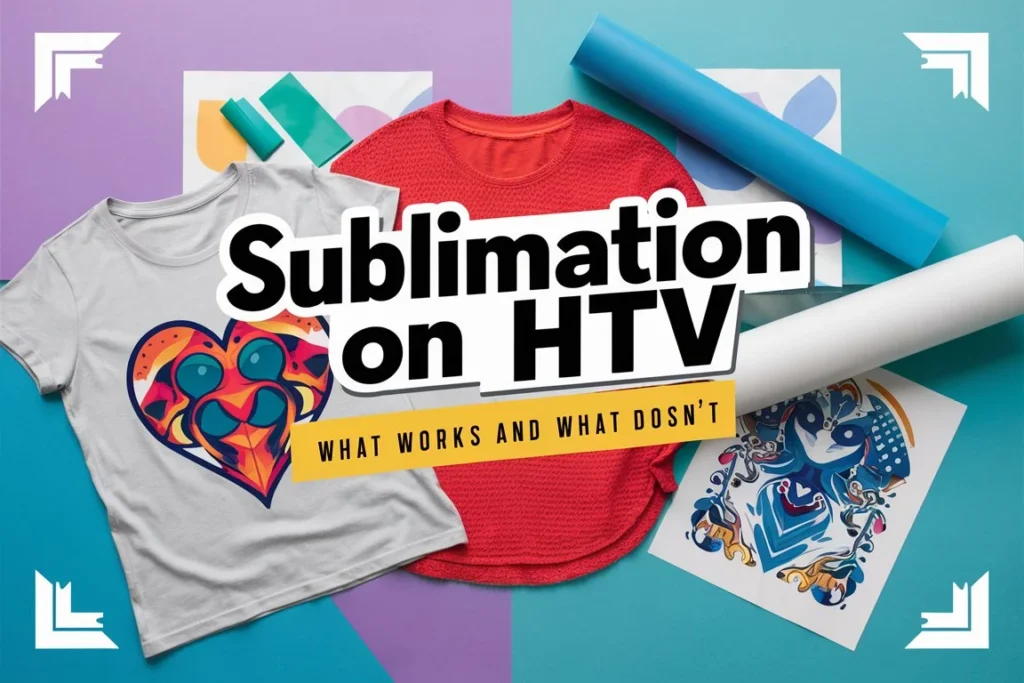What HTV can you sublimate on? Sublimation and HTV are two different processes to decorate fabrics and other items with designs. Well despite having almost a same aim they can not recommended to be used at once because:
Table of Contents
What HTV can you sublimate on: Process Difference
In the sublimation process the fabric is dyed with colors according to the design that is considered more permanent than HTV because in the HTV process an extra layer is added to the fabric on which the design lays.
Heat Settings
Both the sublimation process and the HTV process have different heat settings. Both are supposed to be used in different temperatures and if used at once it could damage the fabric or HTV.
There are a couple of different ways if you want a design on a shirt that uses both techniques at once but these are not recommended for beginners, try them only if you are expert enough.
Option 1: Use Special HTV
So the question arises that can you sublimate on vinyl. Not all HTV are made for sublimation but there are some special clear HTV made for sublimation also called sublimation vinyl. They are clear HTV and have a special coating that allows the dye to pass through. The material this is composed of allows the sublimation paper to have an approach to the underneath of fabric that creates a design that seems like it was directly sublimated.
Here we go with the steps of this process. Some steps are the same as the simple process but some are differ from them, however every step is explained from the beginning here.
Create a Design
Create a design on your computer or get a premade design, remember to have a format that your machine supports. Remember to mirror your design because it gets flipped while printing.
Print It:
Insert your sublimation paper into your machine according to instructions given with your machine manufacturer. Remember to use the printable side for printing, usually the shining white side is the printable side of the paper. Using sublimation ink, print heat transfer paper with your design.
Transfer to HTV:
Here it gets interesting, there are different methods of securing your sublimation paper to HTV depending on the manufacture and brand of HTV. Some recommend using a heat-resistant tape to secure the paper to HTV so the paper does not move during the heat transfer process and Some manufacturers might include special transfer sheets that act as a barrier between the HTV and the sublimation paper; these sheets allow the dye to pass through while protecting the HTV’s adhesive backing. You have to follow the specific brand’s instructions for the pressing process.
Transfer to Fabric:
Once the design has been successfully transferred to the HTV, you can apply it to your chosen fabric using a heat press. Again follow the manufacturer’s instructions for temperature, pressure, and pressing time specific to your HTV product. Remember, there are multiple brands out there that provide the Sublimation HTV but each brand or manufacturer has its own design.
And now you have used both techniques together at once, let’s head to the next option.
Option 2: Sublimate and Layer
In this option, you can simply sublimate first on a fabric and then layer a HTV design on it. Here are some simple steps.
Create a Design
Create a design on your computer or get a premade design, remember to have a format that your machine supports. Remember to mirror your design because it gets flipped while printing.
Print It:
Insert your sublimation paper into your machine according to instructions given with your machine manufacturer. Remember to use the printable side for printing, usually the shining white side is the printable side of the paper. Using sublimation ink, print heat transfer paper with your design.
Transfer The Sublimation:
Make sure that the fabric is clean, dry and wrinkle free. Preheat your heat press, the usual temperature ranges from 193°C to 204°C but always prefer your manufacturer’s instructions. Secure the sublimation paper onto the item/fabric . Place your printed sublimation paper onto your blank item/fabric, with the design facing down against the material. Carefully transfer your design using the heat press according to the recommended time and pressure settings for your specific blank item.
Taking It Out:
When the time is completed, carefully lift the heat press handle and let the item cool completely. Do not touch the item until it gets cool. Once it is cool, carefully peel off the sublimation transfer paper, the design should now be permanently transferred onto your item.
Cut your design:
Now cut your HTV design using a cutting machine and also remove any excessive vinyl for a cleaner look.
Transfer The HTV:
Preheat your heat press according to the recommended temperature for fabric and light transfer paper by your machine manufacturer. The usual temperature ranges from 149°C to 177°C but always prefer your manufacturer’s instructions. Select the place where you printed your sublimation and position it accordingly. Place your printed design face down onto fabric. Carefully transfer your design using the heat press according to the recommended time and pressure settings for your specific transfer paper and fabric.
And now you know both methods, while there might be some niche reasons to explore specialty sublimation HTV, for most crafters, the limitations and potential challenges outweigh the benefits. Consider if your project goals can be achieved with alternative methods like sublimating on printable fabric and layering with regular HTV, or using regular HTV alone. These options might offer a simpler and more reliable approach.
FAQs
Can I sublimate directly onto HTV?
Not technically. Sublimation works best with polyester fabrics, while HTV sits on top of the fabric. The dye wouldn’t integrate properly, and the heat settings differ.
What are the advantages of sublimating on HTV?
There aren’t many clear advantages. In most cases, it’s not recommended. However, for specific craft needs or experimentation, it could be an option.
Isn’t HTV just a type of vinyl?
HTV is a type of vinyl, but there’s a difference! Vinyl is a broad term for various adhesive materials used on non-fabric surfaces. HTV is specifically designed for fabrics and uses heat activation instead of adhesive.
What is HTV?
HTV stands for Heat Transfer Vinyl. It’s a thin sheet of vinyl with a heat-activated adhesive backing. You cut your design into the HTV with a cutting machine, weed out the excess material, and then use a heat press to apply it to your fabric.
What is sublimation?
Sublimation is a printing technique that uses heat to transfer dye from a special paper directly into the fibers of a fabric. This creates a permanent, vibrant design that won’t crack or peel.
Which is better, sublimation or HTV?
A: It depends on your project! Here’s a quick breakdown:
Sublimation: Ideal for polyester fabrics, vibrant colors, and a smooth finish. Not suitable for cotton or other natural fibers.
HTV: Works on a wider variety of fabrics, including cotton and blends. Offers a wider range of colors and finishes, but the design sits on top of the fabric.
How long do sublimated or HTV designs last?
Both sublimation and HTV designs can be very durable with proper care. Follow the washing instructions for the specific fabric and avoid excessive heat drying.


